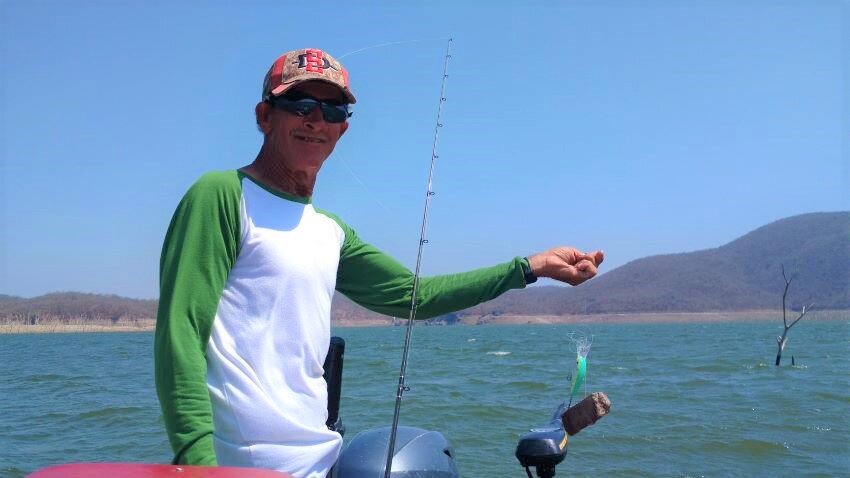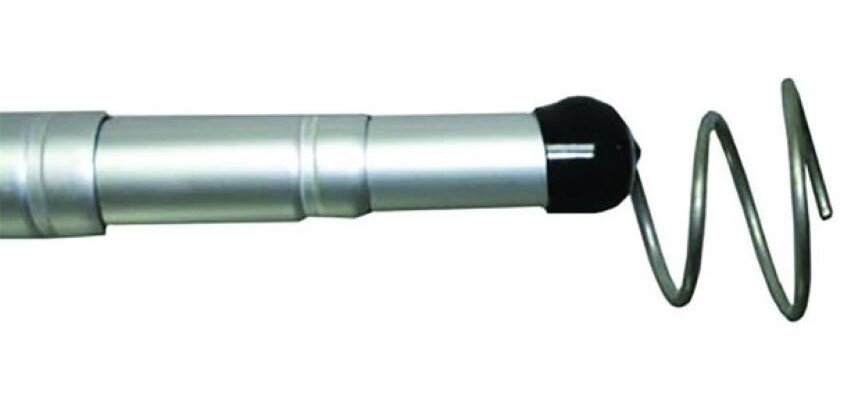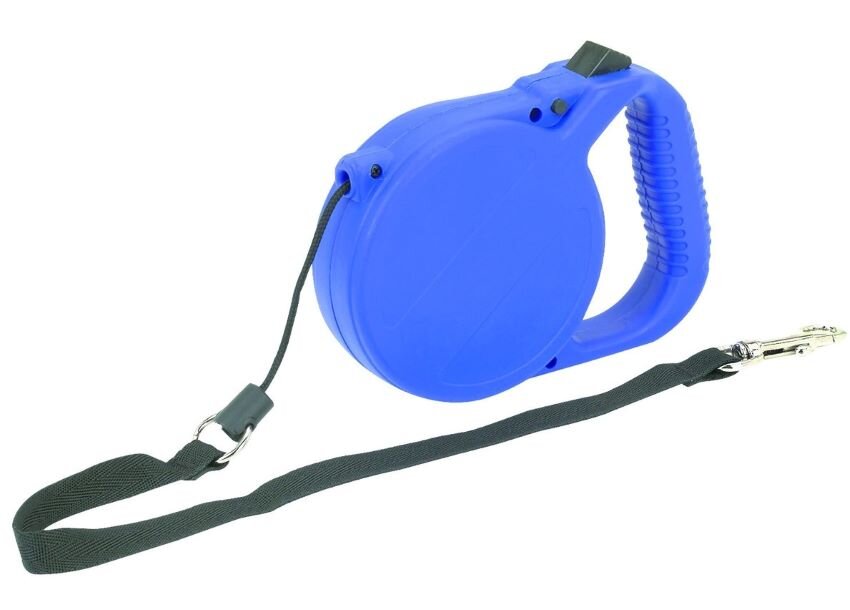Saving Lures, Saving Money
On our May 2013 trip to Lake El Salto, Hanna and I brought a group that included 2010 Forrest Wood Cup champion Kevin Hawk, one of the nicest and most technically-savvy anglers I’ve ever met. He’d won the title at Georgia’s Lake Lanier with an exacting, multi-pronged strategy, and like me he was a tackle nerd.
In his rod tube Kevin brought a sawed-off baitcasting rod, which he paired with an old round reel filled with 100-pound test braid. This rig wasn’t for some super-secret presentation, but rather as a means to get back snagged lures. He tied on a standard plug knocker and kept it at the ready for when one of his crankbaits invariably found itself lodged on an underwater bush or tree. He’d run the plug knocker down his main line, and then “yo yo” the heavy piece of lead against his bait. On many occasions it would push the lure free and he’d get it back. Boom -- $8 to $10 saved. Today those figures might be even higher: a 10XD retails for $14.99 at Tackle Warehouse and $16.99 at Bass Pro Shops. There are more expensive crankbaits and jerkbaits out there, as well as triple-figure gliders and swimbaits that put those purchase prices to shame. By spending a few bucks on a lure retriever and pairing it with gear that he already owned but wasn’t using, Kevin saved himself a lot of money.
Of course, beyond the money saving side, there was also a practical application to this effort. With a 50-pound limit on his checked luggage, Kevin was of course limited on the amount of tackle he could bring. If the fish were biting a citrus shad Fat Free Shad or a “Rasta” Rapala DT20 better than anything else, he might only have one or two of the hot lure. Losing it early in our weeklong trip could’ve spelled a minor disaster.
Eventually, Kevin suffered a crankbait snag that he couldn’t get unbuttoned. He worked on it unsuccessfully with his homemade contraption for a while, and was ready to give up and tie on something else, when his guide Lacho intervened. I’ve since fished with Lacho several times, and while he’s an exceptional guide, he’s not a big talker. He understands and speaks far more English than he initially lets on, and he’ll give you subtle encouragement or corrections as needed, but don’t expect to swap long stories or exchange life-altering secrets. He’s there to do a job and put you on fish, not to gab, so when he pipes up it pays to listen.
Lacho motioned for Kevin to stop trying to break the line and instead to hand it to him. He then pulled out a small rock--nothing special about it, one of several that he’d apparently plucked from the shoreline that morning—affixed to a loop of monofilament. He slid it down Kevin’s line, popped it once, and the lure came loose. Over the ensuing eight years, I’ve seen Lacho do the same thing time and time again, not just with a rock, but also with comparatively “high tech” tools like a combination lock and a spark plug. He’s saved anglers thousands of dollars and lots of heartbreak over the years.
Other guides around the world have done the same for me and others. In both Mexico and Brazil, I’ve seen them get into the water or climb trees to get back snagged or errant baits. The guides in Zambia, where hippos and crocs patrolled the fishiest waters, were less keen to do so. I once had a guide leave my lure snagged, cut the line and tied it to a bottle, and then came back after he dropped us off to get it back so we’d have our lures and also maximize fishing time. Generally, I consider myself pretty good at getting lures back on my own, but the guides who do it for a living are generally much better. Furthermore, because they don’t take material goods for granted as much as us gringos, they tend to work harder at it.
When you’re at home, it pays to work on techniques for retrieving snagged lures. Of course, it they’re shallow, you can often get them by hand or push your rod tip against the lure to free them. If you employ the latter technique, be sure to check that you do not push the ceramic out of your tiptop guide or harm it to the point that it will nick your line on the cast or retrieve. If that happens, replace it before you suffer avoidable heartbreak. You can also use the “bowstring” technique to free hung baits, although this works better with monofilament and fluorocarbon than it does with braid, which has minimal stretch. Learn to feel what you’re hung up in, because the strategies that you employ for a single-hooked lure in rock may differ from those for treble-hooked lures in trees, or any lures in a discarded tilapia net.
It also pays to keep some sort of lure retriever handy. While most of these are fairly low-tech, every angler seemingly has their own preferred method and apparatus. I keep a T-H Marine Money Pole Lure Retriever in my boat for this purpose. It telescopes from 6 feet all the way to 18 feet, is made of aluminum, and has a corkscrew at the end to maneuver down your line and push lures free. I seem to remember that I spent about $40 for it, but now see that it is over $100. If that’s too rich for your blood, or you think it won’t pay for itself but you want one, there are similar items from Dotline and Frabill that cost substantially less. The DIYers among you might even craft your own.
The extendable pole lure retriever is very effective, but it’s not always practical, particularly if you’re flying to a fishing vacation, and especially if your luggage will be limited in terms of weight and size. Fortunately, there are a variety of other gizmos and contraptions that can be purchased and slid down your line. They won’t always be effective, but at prices of $10 to $40 apiece, most will pay for themselves rapidly. Almost all involve a heavy “pusher” with some way to attach it to your line. Their strategies diverge from there, with some of these have wire harnesses meant to grab and dislodge your lure, while others have series of chains meant to grab your hooks. Then you can use brute force to free all or a portion of the obstruction—whether it be a tree, brushpile, branch or net—and bring the whole mess to the surface, with your lure.
Others are even less expensive and less technologically-advanced, like the various commercially-available “pocket rocks” that are just a modernized version of Lacho’s shoreline finds. Many of them are covered with plastic dip to protect your line and lure, while some are simply a heavy sinker with an embedded snap. You can make your own with heavy lead sinkers and zip ties, and if you pour your own weights the cost will be minimal.
No matter which of the standalone lure retrievers you purchase or make, there are also multiple ways to deliver it to the snagged lure. You can do it like Kevin Hawk, using an old reel and portion of a rod spooled with heavy braid. You can also go even simpler, with a section of parachute cord-wrap it around a dowel or a discarded water bottle to keep the line out of the way. One other way to control your line in this situation is by attaching the lure retriever to a retractable dog leash, which can be purchased for a few bucks at the Dollar Store, through Amazon, or at a yard sale.
I would never encourage anglers not to attempt casts into thick cover or tight spots. Sure, practice at home and don’t overestimate your accuracy, but high risk casts often come with high rewards. Don’t mourn lost baits, either. They’re meant to be fished. At the same time, with a little bit of effort and forethought, you can keep your tackle box stocked and avoid running out of that “magic lure” or “the only one they’ll bite.”






